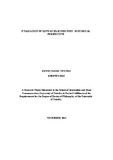| dc.description.abstract | This evaluation of the Kenyan film industry from its historical foundations, tried to fill a
gap of shortage of data on history of film in Kenya. It traces the historical development of
the film industry, the policies and institutional frameworks, impacted by changing political
circumstances and technological developments over the study period from colonial Kenya
to the present.
The qualitative study used both primary and secondary data methods. Primary data
collection involved interviewing key informants who are policy makers and custodians of a
lot of the information related to the management and the operation of the Kenyan film
industry. This included policy makers in government and the CEO of FEPACI the
regional film organization, and senior film producers some who have been in the industry
since the 1970s.
For secondary data, the study carried out a rigorous critical evaluation desk study at the
Kenya National Archives and Data Services (KNADS), local libraries and websites
featuring film production in Kenya. For data on the colonial period, the research benefited
greatly from data from the British Film Institute from where the researcher was able to
access and preview relevant films from that epoch. For the postcolonial epoch, there was a
lot of data available from KNADS. The desk study gave the researcher a clear grasp of the
different issues and the stages that the Kenyan film went through and the challenges and
opportunities at varying moments along the way. Because film’s communicative power is
in representations of reality on the screen, the study also evaluated how Kenyan people
have been represented on the screen during the era under study by critically analyzing
films, purposively selected from three epochs of the study period. The selected films
included the colonial epoch when film propaganda became a major weapon against the
nationalist struggle for independence, the postcolonial epoch, in the mid-1980s when the
film industry was on the verge of takeoff, and for the contemporary epoch, 2012, when the
Kenyan local film industry made its impact on the global screen.
The study outlines how the industry developed and how policies were made to suit regimes
in power. In the post-independent epoch, there are revelations of whimsical policy
decisions, made by middle level bureaucrats, which condemned great enterprises to start a
film industry in the 1960s. The study also lays out the evolution and the establishment of
Riverwood film industry. A surprising finding is the extent to which South Africa has risen
to dominate cinema in Kenya since the end of Apartheid. The setting up of a Kenyan
Schools, Colleges and Universities film festival indicates a bright future for the Kenyan
film industry. The study makes many recommendations, including the improvement of
distribution and marketing of movies in Kenya; professionalization of the Riverwood film
industry, and a more rigorous study to affirm the chain-link of their business. Among many
other recommendations are the measures to take, as the industry’s management is devolved
to the Kenyan counties. | en_US |

